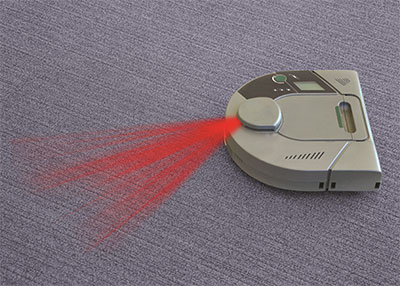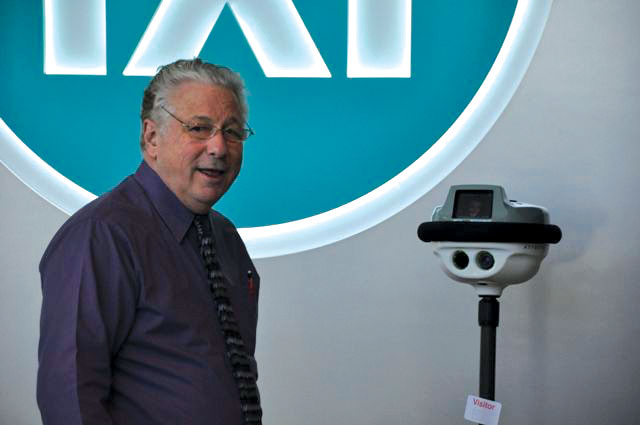By Bill Laumeister, Strategic Applications Engineer
Abstract: Robots are everywhere, even though we may not realize it. This application note describes the prevalence of robots in our daily lives-from vacuum cleaners to lights to devices that allow us to be in two places at once-and our reliance, not only on them, but on the hundreds of microprocessors that enable the “robots” we encounter every day.
A similar version of this article appeared in the March 5, 2013 issue of Electronic Design magazine.
Introduction
Two thousand years ago, a Roman citizen might count his slaves to determine how many tasks could be accomplished. Early in the twentieth century, one could count electric motors to answer the same question. Today, we count microprocessors. There are more than a hundred microprocessors in many modern homes, not counting the 50 to 80 processors in modern automobiles. And in fact, a microprocessor is a modern-age robot, “a mechanical or virtual artificial agent.”1

Figure 1. A modern home with all the lights blazing and the electric meter spinning—an indication of the many hidden robots at work.
The Age of Robots
The age of robots is upon us. A few decades ago, it was science fiction, but in the next decade or two, more and more robots will populate our homes. Isaac Asimov, best known for his science fiction stories, formulated the “three fundamental Rules of Robotics”, more popularly known as the “Three Laws of Robotics”, which are designed to constrain robots from harming humans. Asimov said, “I do not fear computers. I fear the lack of them.”2 We agree. If we removed microprocessors from our homes, our standard of living would plummet.
In a 1965 paper, Gordon Moore proposed a concept that would become known as “Moore's Law.” He envisioned a digital technology that increases very rapidly by shrinking transistors and thus, greatly increasing the density of microprocessors. In the process, the cost of individual transistors would also decrease, making more powerful processors affordable. Mr. Moore's foresight was astounding. He said:
The future of integrated electronics is the future of electronics itself. The advantages of integration will bring about a proliferation of electronics, pushing this science into many new areas.
Integrated circuits will lead to such wonders as home computers-or at least terminals connected to a central computer-automatic controls for automobiles, and personal portable communications equipment. The electronic wristwatch needs only a display to be feasible today.3
And that was 48 years ago! Today we sit composing articles with voice recognition, at home on a laptop, and backing up on a cloud. We drive cars with more than 50 processors; stay in contact, worldwide, with voice, email, and video on a smartphone; and buy digital watches for less than $10. These are exciting times. Our innovations and standard of living are limited only by man's imagination.
But back to Moore's Law. It has been modified slightly over the years, but the concept is solid. Today we say, “Transistor density on integrated circuits doubles about every two years.”4 This is akin to compounded interest in banking and has held true for the last 48 amazing years. To illustrate, in 1971, Intel's 4004 processor contained 2,300 transistors. In 1978, the 8068 had 29,000. In 1989, the Intel486 contained 1,200,000 transistors. In 1999, the Intel® Pentium® III processor had 9,500,000 devices. Then 2009 found Intel processors with 774 million transistors,5 and 2011 dawned with 2,270 million transistors.
As exceptional as the density increase is, the rest of Mr. Moore's prediction has also come true. The price of microprocessors has declined so they have proliferated everywhere. You can now buy little processors for less than $1 for a single one; in high volumes, they are just pennies. Engineers also saw that a programmable microprocessor could be sold as a stand-alone processor, thus kicking off the Intel families of processors.
Today, manufacturers of specialty items can choose a general-purpose processor over a completely custom IC. This decision is made on volume versus cost, return on investment (ROI), and time to market. As an example, consider a simple decorative LED solar garden light that retails for $3.33 (U.S.). A block diagram for an application-specific integrated circuit ( ASIC) might include a solar cell, one AA rechargeable battery, a boost converter for charging the battery and running the LED, a clock oscillator, a state machine (sequence counter), and LED switching transistors. The alternative is to use a small microprocessor with a few external transistors and diodes. The choice is an economic decision, because the ASIC has the relatively high front-end cost of non-recurring engineering ( NRE). Low volumes may dictate the general microprocessor approach.
The one constant in the microprocessor race is that they all use electricity. A consequence of smaller transistors is lower power, which leads to longer battery life. Robots, or “household helpers”, need electricity to operate. The decision to use an AC powerline, rechargeable battery, or replaceable batteries is made for each application. The key fob that opens the car door is not rechargeable, but the coin-cell battery needs to be changed only once a year. Electronic meters for natural gas and water may run 10 to 40 years before the battery must be replaced, and many appliances are plugged into our home's AC powerline. Where are we going with this? The age of robots, envisioned so clearly by Gordon Moore back in 1965, is now a ubiquitous part of our daily lives…and many of us do not realize it.
Robots-Everywhere But Not Noticed
As we contemplate the delivery of electricity, we can ask ourselves, “Could we build what we might consider life necessities from scratch?” Sadly, most of us could not make the items that we use in our daily life or have around the house. What about simple things? A ball-point pen, remote controls, solar garden lights, or anything with even the simplest microcontroller?
Before we get to the typical modern home with the simplest of machine robots, we need to consider the municipal, governmental, and other external support services that all rely on robots. Today our comfort and well-being is predicated on the availability of unobtrusive services operated and maintained by microprocessors. Last night driving home from work, I phoned my wife and asked if she needed something from the store. In that one action, we relied on microprocessors in the cell phones and towers, the automobile, even the traffic lights. Our count of these supportive “necessities” is over 90 items: electricity, drinking water, natural gas, sewer and garbage services, fire and police services, repair services for automobiles and appliances, and even things like grocery stores. These robotic services are ever-present, so much so that we ignore their importance.
Robots in the Home
Now back to a home, my home, which I consider typical for an urban dweller with grown kids. We started counting motors (158) and electrically operated machines (87) and then microprocessors (278).
Microprocessors are everywhere, from light dimmers, timers, and remote controls to battery-operated candles and solar garden lights…and it is not just one of each kind. We have multiple phones, lights, computers, printers, CO alarms, battery-powered hand tools. Would you believe eight smoke alarms that form their own wireless mesh network? There is programmed air conditioning so we can sleep at night. We no longer bash our clothes on a rock in a stream because we have clothes washers and dryers, and the hot water to support those appliances. We are saved from boredom because we have two digital video recorders (DVRs) that can record four satellite channels and three over-the-air channels simultaneously; two boxes that stream video from the Internet; and two DVD players that go with the surround sound. Wow, I need to stop, but I have made my point. We are spoiled by our lifestyle, but none of this would work so well when we want it and at the right temperature or brightness, if robots were not everywhere and the supply of electricity to power them reliable.
Let's look at a few robots that are becoming affordable for general household use.
Vacuum Cleaner Robots
We have two semi-autonomous robotic vacuum cleaners: a Roomba® and a Neato Robotics® XV-11 model. The Roomba is older and utilizes a semi-random pattern bounded by walls, stairs, furniture, and IR beams. The XV-11 model first maps the room with an IR laser and then programs itself to perform an efficient back-and-forth motion. Both the Roomba and the Neato vacuums return themselves to their charging stations. The Roomba, however, needs to be restarted because it has no memory. The XV-11 can return to the room from which it came and resume its work; it can recharge as many times as necessary as it goes from room to room to clean the whole house.

Figure 2. Robot vacuums, such as the Neato type pictured here, are intelligent agents that utilize an IR laser to scan the room, detecting the perimeter, furniture, doorways, and even people to guide themselves.
The robot's microprocessor acts as a director in a movie or video, supervising all vacuum and cleaning actions and allowing it to run unattended most of the time. There are a few exceptions, and any automated device can fail. Once a rug was frayed and the robot tried to eat the string; at other times it sees its dustbin as a fun toy box. In either case, it is smart enough to stop and beep for help. The LCD display tells us what is bothering the robot, so we don't have to guess. All this leaves me more time to work on my “honey-do” list, and this also pleases my spouse.
Fine, you say. This is “cool engineering” for me. But do we really need a robot vacuum? Couldn't we use a manual vacuum? Yes, of course, but there are other advantages. The main advantage is time, time to do other things. Either of these robots uses less power than our manual vacuum, which makes it greener. But more important, it can be scheduled to run and reduce the normal dust build-up, thus improving the health of all of us living there.
Lighting Like No Other
Let's now talk about lights, perhaps not so obviously robots, but still robotic in function. Our front entryway has an up-lighted vaulted ceiling. The ceiling is essentially bumped up with a trough facing upward around the bump. The LEDs are in the trough with only the reflection from the bumped ceiling visible. The LED light color can be changed by an IR remote control to suit one's mood. There are two microprocessors, one in the remote control and one in the trough to receive the IR and switch the LEDs. The color, fade, or flash rate between colors can be varied by remote control.
Outdoors the pathways are lighted by LED solar lights; other LED lights cycle through red, green and blue for decoration. They are solar-powered and do not add to my electric bill. A specialized microprocessor can charge the battery from a solar cell and sequence the colors. These automated LEDs replaced a wired 12V system with a plug-in AC transformer that was a maintenance headache when cultivating around the plants.
There are compact fluorescent lights (CFL) throughout the home, and many are dimmable. The dimmers in the house are controlled, or remote-controlled, with specialized ICs or microprocessors. Even CFLs made for dimming have an annoying defect when dimmed with other CFLs. They “talk” to each other through the powerline, and at some settings, the switching power supplies in each CFL try to synchronize and blink on and off. Ironically, the fix is to replace one CFL with an incandescent light. The low impedance of the incandescent light swamps out the current pulses of the CFLs and prevents the crosstalk. This shows how the old technology can rescue the microprocessor.
There are IR-sensitive security lights on the outside that sense and hopefully, deter intruders. We had trouble adjusting the IR sensor to activate the light when someone (at a cool temperature) was in the driveway and yet to ignore the hot radiators of the cars coming up the street. We solved this issue by adding radar at 10.5GHz with a smarter microprocessor. I know that it does sound like overkill using both IR and radar “sight” for an intelligent agent (read, robot) just to control a light. Nevertheless, I am an engineer and we do have the technology to get around nature.
The hot tub has a light, originally a 12V AC incandescent bulb controlled by a switch. To add “mood lighting,” that light was replaced by RGB LEDs designed to be controlled by a single on-and-off switch. The inputs to the LEDs are, of course, rectifier diodes to convert the AC to DC and charge a “large” capacitor, hence a large time constant. The clever part is a second path from the AC line that has a shorter time constant. The main power comes from the large capacitor and the second path signals that the switch has been turned off for a moment. The main power essentially ignores the short interruption, while the second path increments a counter to change which LEDs are lighted and to control the mood lights; one setting causes the LEDs to slowly cycle through all the colors. The hot tub runs at 100°F, so guess what happens to the large wet electrolytic capacitor? When we pulled the LED bulb assembly out of the hot tub, the main 470µF capacitor was swollen and dried out. Soldering in a new capacitor fixed the issue for another year.
More Robots
How about a telepresence robot? One that can be sent to work for me so I can troubleshoot remotely. Basically, a robot to let me be in two places at the same time. Really? Yes, really.
We borrowed a QB Avatar robot from Anybots® and tried out their Virtual Presence System at Maxim's headquarters in San Jose, California. We attended meetings and communicated as if we were actually there in person. Speaking as an engineer, “it was fun,” and we could see how it could save travel time and allow us be in two spots at the same time.
The QB Avatar balances on two wheels using gyro-controlled microprocessor servos. The machine is an inverted pendulum, weighs just 32 pounds, and is safe around humans. QB Avatar lives in a cloud and we can control it worldwide through the Internet with a special ultra-low latency video protocol. It enables real-time collaboration, virtually in-person, aiding the troubleshooting of customer equipment. We can look over the engineer's shoulder, and see the same oscilloscope, meter, or spectrum analyzer just as they see it. This also makes it easier to train our personnel.

Figure 3. Meeting my alter ego, the QB Avatar by Anybots, which allows me to help customers troubleshoot issues and to be in two places at once.
My next robot “want” is one that we have been looking at for more than a decade. Christmas machines, now called 3D printers, were $25k to $50k back then. They allow one to design and build three-dimensional models without investing in expensive molds. Today, there are very good professional models for a few thousand dollars that can build larger objects in plastic and metal. The consumer or hobbyist models only build objects in plastic for now, but they start at $400. This cost is in the realm of a paper laser printer and in the range where I can buy a toy for myself. Now my limitation is time: the time to learn to use the 3D design software. I'm looking for a cool first project, and any ideas are welcome.
Conclusion
Most of us enjoy an unprecedented comfortable lifestyle enabled by microprocessors performing robotic functions around us. Yet, we rarely think about these robots, and it is sobering to realize how quickly all that automated operation would collapse without electric power. Once when we lost power, we found ourselves walking into rooms and flipping on light switches. This was reflex (robotic, if you will). Then when the power returned, we felt really ridiculous as almost all the lights in the house were on. We went from room to room, using remotes to turn off lights. Oh, but we are so typical. We use robots without thinking and even try to make them work when they simply cannot. When will we learn?
References
You can start reviewing the dialogue about robots here, http://en.wikipedia.org/wiki/Robot.
- “Isaac Asimov,” BrainyQuote.com, Xplore, Inc., accessed March 7, 2013, www.brainyquote.com/quotes/authors/i/isaac_asimov.html.
- Gordon E. Moore, “Cramming more components onto integrated circuits”, Electronics 38, no. 8 (April 19, 1965): 114-117; http://download.intel.com/museum/Moores_Law/Articles-Press_releases/Gordon_Moore_1965_Article.pdf.
- Backgrounder, Moore's Law: Raising the Bar (Intel Corporation, 2005), http://download.intel.com/museum/Moores_Law/Printed_Materials/Moores_Law_Backgrounder.pdf.
- Chris Hare, “Current Processors Chart,” PC Hardware Links, last modified: January 22, 2013, http://pclinks.xtreemhost.com/current_cpus.htm.
Advertisement
Learn more about Electronic Products MagazineMaxim Integrated





